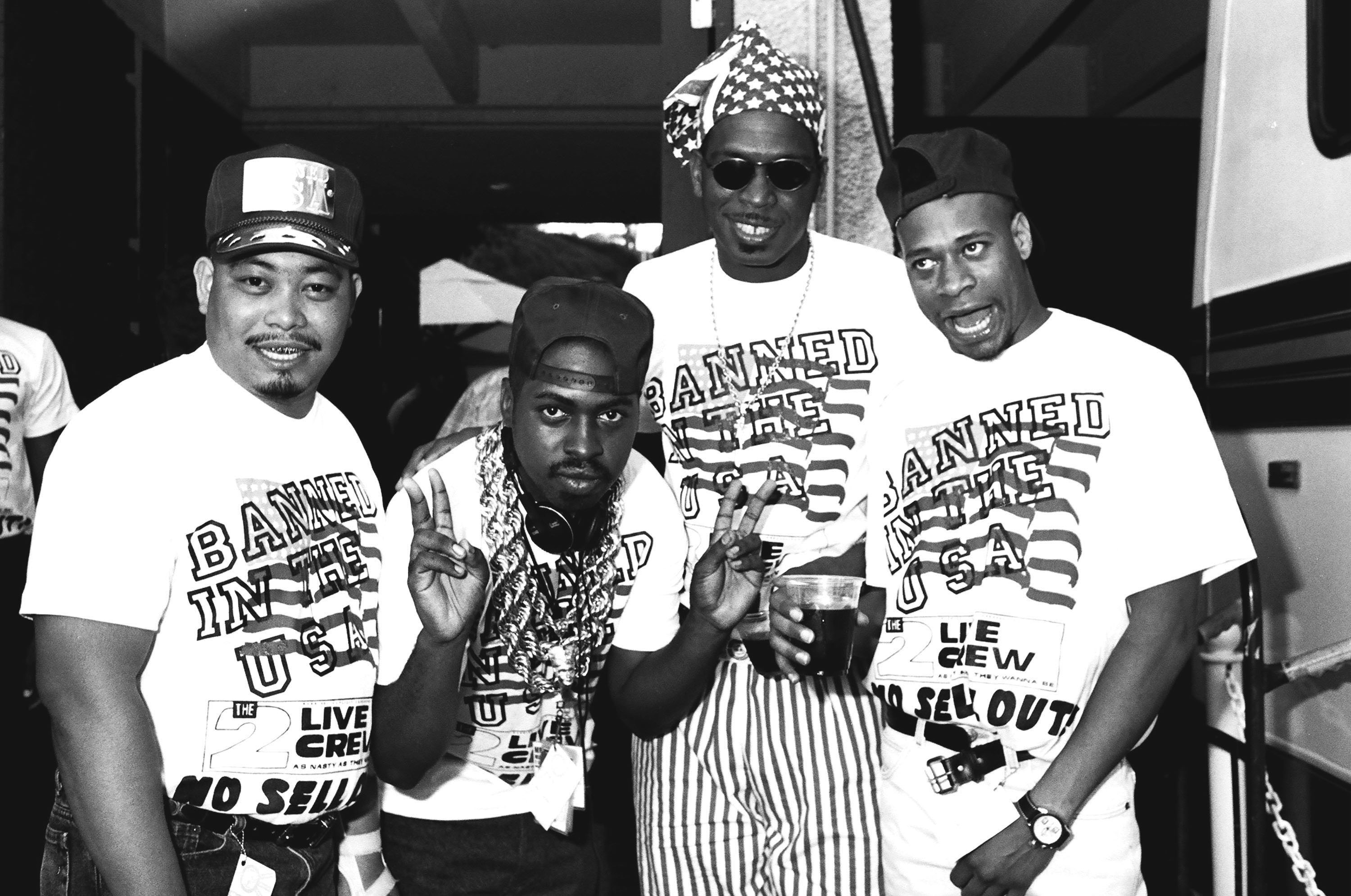How DJ Laz Put The Latin Flavor in Miami Bass
It’s been three decades since bass music first boomed out of Miami’s roller rinks, teen clubs and car-cruising strips, and about half as many years since it was drowned out by less distinctly local sounds. Yet a handful of booty shake records retain an exalted, unmissable presence in the muggy ether of Magic City nightlife. DJ Laz’s “Esa Morena” is, unequivocally, one of these. Though little known beyond a few pockets of the Southern US, the 1996 single remains deeply embedded in Miami culture, even as other once-ubiquitous classics of the genre have faded away.
“‘Esa Morena’ is like Miami’s ‘Hypnotize’ or ‘Gin and Juice,’” says DZA, house DJ for Miami’s Peachfuzz party. “The moment that song comes on, it’s like instant cheers.”
The reactive agent in “Esa Morena” is the sound of merengue, channeled partly through a sped-up sample of Dominican singer Kaki Vargas’ “Los Mosquitos Puyan.” In a city where Spanish is most residents’ first language, “Esa Morena” and its 1991 precursor, Laz’s “Mami El Negro” bridged the gap between the homegrown bass sound birthed in historically black Liberty City and Overtown, and the traditional Latin music much of the rest of the city was raised on.
“You can be in a club, tipsy drunk, talking to some chick about ‘I’m about to take you home,’ but the moment you hear that bat-da-la-bap-bap-bap-bap-bap-bap, it catches your attention,” says Carlito “Broadwae” Guzman, who collaboratored with Laz on “Esa Morena” under the name Daddy Celo. “It’s something I can relate to, because it’s my culture. It’s that mixture of the Latino rhythm, and the actual bass music.”
Laz – who would become one of Miami’s best-loved radio personalities during his 22 years at “Miami’s Party Station,” Power 96 (WPOW FM) – first tapped into that mixture as a teenage DJ prodigy. The son of Cuban immigrants raised between Little Havana and nearby Hollywood, Florida, Lazaro Mendez was born with a severe muscular disorder that confined him to a wheelchair for much of his youth. His handicap would catalyze his music career, however, inspiring him to hone his DJ skills with razor-like focus. By age 16, he’d already landed his first radio gig at Miami’s Hot 105 (WQHT FM). “I had a lot of time on my hands because of all the surgeries I had as a kid,” Laz recalls. “I’d be at home scratching and mixing on the turntables because I couldn’t do anything else.”
“The Pimp with the Limp,” as Laz would become known to generations of Miami radio listeners, was home one night with his turntables when he had the idea to blend Wilfrido Vargas’ merengue classic “El Africano” – a staple at any Miami Cuban celebration – over the sustained 808 kicks of a booty shake beat. “Everybody that would come over after that, I’d play them the booty beat, and then I’d mix in Wilfrido Vargas, and they’d say, ‘This shit sounds good. ‘I had a mix coming up on the radio, and I said, ‘I’m gonna try it.’ And, as soon as I did, the phone lines lit up.”
Laz next took his blend to the clubs, where he found a similarly enthusiastic response. But when he approached prospective record labels about putting his fusion on wax, few saw the potential. “I remember traveling to New York, and I went to see Aldo Marin over at Cutting Records, and he loved it, but nobody wanted to take that chance,” Laz says. He ultimately found a home in Bo Crane’s Pandisc Records, a Miami label behind such seminal bass records like Young and the Restless’ “B Girls” and Maggotron’s “The Bass That Ate Miami,” as well as freestyle classics by Pretty Tony and Debbie Deb.
“This was just the next logical step,” Crane recalls. “What Laz did, nobody had done before. It was one of those happy accidents, or experiments, that works out.”
Adding some lines sampled from Cuban comic Álvarez Guedes and rhymes from rapper Danny D, Laz cut “Mami El Negro” at International Sound Studios in North Miami in 1991, along with the rest of his self-titled debut LP. (Though he’d rap on other songs from the album and on successive releases, Laz did not contribute vocals to “Mami El Negro”). Pandisc also commissioned a video for the song, depicting a scenario inspired by Geddes’ line, “Un americano que no sepa hablar español, y vaya a una fiesta de Cubanos, tiene que estar loco.” (“An American who doesn’t speak Spanish and goes to a party with Cubans has to be crazy.”) And, in a nod to a prevailing sentiment among Miami Cubans at the time, the clip depicted partygoers smashing a piñata in the likeness of Fidel Castro.
When I heard “Mami El Negro,” I was like, “Hold on – there is a lane for Latinos to be involved in this music culture.”
There were already a handful of Hispanic DJs active in the bass scene, but “Mami El Negro” was the first booty shake record to expressly appeal to Miami’s majority, inviting more Latinos into the subculture and giving those who’d already embraced it an anthem they could call their own. “When I heard ‘Mami El Negro,’ I was like, ‘Hold on – there is a lane for Latinos to be involved in this music culture,’” says Guzman, a New York native who, like many transplants to Miami, admits to disliking bass at first. “If you looked at [bass] without “Mami El Negro,” you might think you have to be black or African American to do that.”
Though “Mami El Negro” never gained traction nationally, it hit hard in places like San Antonio and Corpus Christi, Texas – Southern cities with a Latin accent, and an established taste for bass. “I was in Texas every weekend for three or four years,” Laz recalls. “The first show I did there, I opened up for Selena.” And thanks to a live show that took a page from 2 Live Crew’s bawdy playbook, his legend grew with each visit. “We brought out the baddest women anywhere,” Laz recalls. “I would travel to Texas with Miami girls, and people from Texas did not know what to do with themselves. They were like, ‘Oh my god, where do you find girls like that?’”
With “Mami El Negro,” Laz had developed a formula for Latin bass, which he’d revisit on each of his six full-length LPs, mixing in merengue- and salsa-fueled creations like “Latin Groove” with more standard bass fare like “Hump All Night.” On ‘93’s Journey Into Bass, Laz hooked up with Daddy Celo and Trick Dog (later known as Truko), AKA 2-minicanos, for a track called “Shake It Up.” Dominican cousins originally from Washington Heights, New York, the duo were deeply influenced by merengue, and when it came time to work on ‘96’s King of Bass, he tapped them for what would become his signature tune.
“I remember I had SP 1200s in my garage, which wasn’t even a garage, it was like a tool shed,” Laz says of the session that produced “Esa Morena.” “I played the track for them and Trick Dog just started humming. We just sat there and, between all of us, the hook came alive, the verses came alive, and we had the record that was like, ‘Holy shit, this is not just a hit, this is gonna be a classic.’”
The further North you got, the less appealing that particular record and that specific type of sound was to people.
Although the Kiki Vargas sample gave the song its frantic pace, the trio had created something entirely fresh, with a call-and-response hook (sung by Celo and Trick Dog) and lyrics that toasted to dark-skinned women. Geographically, “Esa Morena” followed a similar trajectory to “Mami El Negro,” hitting hard in Miami, then fanning through the South. But, like bass in general, it never quite caught on nationally.
“In those markets where we were strong, we were strong,” Crane says. “I could count on support in Florida, Texas, California – the soft underbelly of the US where there were a lot of Latinos. The further North you got, the less appealing that particular record and that specific type of sound was to people.”
By the time of Laz’s fourth and fifth LPs, 1998’s Cruzin’ and 2000’s Pimpin, bass was losing its hold on Miami, too. Southern rap’s center of gravity had shifted to Atlanta and New Orleans, and local rappers like Trick Daddy were finding success with a more nationally relevant hip-hop sound. Yet Laz was more ubiquitous than ever in his hometown, conquering drivetime radio – first afternoons, then mornings – in the 305. Staying true to the sound that made him, he gave Miami one last bass hit in ‘98’s “Sabrosura.” There was enough demand for Laz’s Latin Bass cuts in 2003 that Pandisc gathered all of the ones he’d previously released for a compilation entitled The Latin Album.
Meanwhile, the spirit of those records found new life and an even broader audience in the bilingual, uptempo club rap of Laz’s protégé, Pitbull. In 2007, “Mr. Worldwide” gained entry into international charts with “The Anthem,” a repackaged “Mami El Negro” featuring Lil Jon. Laz returned to recording in 2008 for Category 6, which included a remake of “Esa Morena” with T-Pain (as “Morena ‘08”) and “Move Shake Drop,” a Pitbull collaboration that reached No. 56 on the Billboard Hot 100, the highest chart position of his career.
In a recent Q+A for Interview, Diplo, who spent much of his adolescence in South Florida’s Broward County, told Rick Rubin that his favorite DJ growing up was “this guy named DJ Laz.” The connection to his current work with Major Lazer is readily apparent in “Watch Out for This (Bumaye),” and “Come On to Me,” salsa-infused electro-dancehall bangers that sample horns from Willie Colón.
At Peachfuzz and Chocolate Sundays, weekly club nights in Miami where DJs play new and old hip hop for young partiers just old enough to have caught the bass era’s tail end, few records encapsulate the energy better than “Esa Morena.”
“I don’t know how some of these young kids know it,” Laz says. “But it’s one of those records that has never died.”

